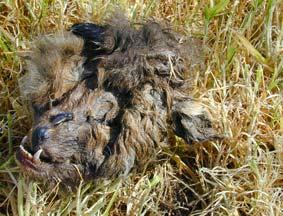Nature: What have we here?

Eanna Ni Lamhna shares with us the (very scary!) contents of her postbag
I greatly welcome the almost universal use of digital photography. What with digital cameras being affordable, and every second mobile phone able to take pictures, this must surely spell the end of bulky, smelly letters arriving through the post to me. These invariably contain the (mostly dead) remains of some mangled creature accompanied by the words, "What is this and what will it do to you?" Often the thing is crushed beyond recognition or smelly beyond belief. I once even received a live bat in an Anadin box.
Photos are much better since they're taken in context when the animal is in its own habitat. Plus, they can be enlarged if necessary to see the finer details. And, in the occasional instance when a second opinion is called for, the click of a mouse can send it to another expert.
Imagine my horror, therefore, on opening my email attachments some time ago to observe the creature photographed here. Just its head was found in the garden of the writer, who wished to know what it could be and why only its head was found. There were several shots of the ghoulish object – one with a fly on its nose to give some indication of its size.
It was quite small – maybe the size of an apple – grey/brown, found in an Irish garden in summer. What could it be? A hedgehog maybe? But hedgehogs have spines, not wild fur, and they have pointy faces and the teeth are wrong. A bat maybe? But it's too small for a bat and anyway they have amazing facial characteristics – nothing like this!
The owner came back to know if I had decided what it was. I hummed and hawed and said I was considering all the options. He then said he had kept the head in his freezer (what was he like?) and could give it to me to assist with identification.
I duly collected the head and decided that it was time to call in the big guns. So, feeling somewhat like Salome, I journeyed out to the zoology department of a well-known university for assistance. We unpacked the now dripping head and looked at it in detail. The teeth were the giveaway – a member of the dog family. The eyes confirmed it – they were blue, so it was a young fox.
But, but... Surely foxes are orange-ish in colour, not like this shaggy beast? Well, when foxes are very young, their coats range from chocolate brown to black in colour and their eyes are blue, changing only to amber after four weeks or so. This baby fox fell foul of predators in its tender youth, hence its appearance. But why only its head? Back to the owner, who informed me that there is a buzzard's nest nearby where several chicks were successfully reared over the summer. The poor baby fox was on the menu for the growing chicks, who probably baulked at eating the hairy, bony head.
I held myself back from taking the head home with me as a trophy. Instead, I magnanimously donated it to the zoology department of the learned institution to reward their identification skills.
